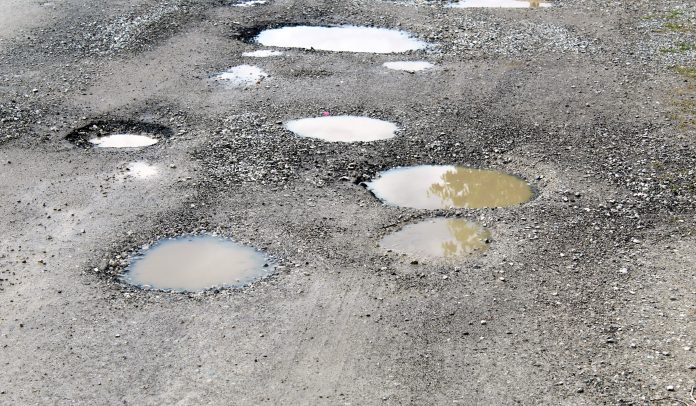The UK government has injected £23m for research into new technology that could help prevent potholes and create new pothole repair techniques
Transport Secretary Chris Grayling revealed that the new funding could help stop potholes from forming.
The government will provide £22.9m for research and trials on new surface materials or pothole repair.
Real-world tests of new road surfaces and technologies in eight local authorities will see which emerging innovations provide long-term solutions. The Live Labs projects will be delivered by Kent, Staffordshire, Reading, Suffolk and Solihull and Birmingham councils, and if successful, could be adopted by other authorities.
These schemes include expanding the test of plastic roads in Cumbria, using kinetic energy off Buckinghamshire roads to power lighting and using geothermal energy created from paths to keep car parks and bus stations in Central Bedfordshire from freezing over.
Transport Secretary Chris Grayling said: “Potholes are the number one enemy for road users and this government is looking at numerous ways to keep our roads in the best condition.
“Today’s trials will see how new technologies work in the real world to ensure our roads are built for the 21st century.”
Research and trials include:
| Buckinghamshire | Ringway Jacobs (Contractors), Transport Systems Catapult, Aylesbury Garden Town, Aylesbury Vale Council, Coldharbour Parish Council, Bucks and Thames Valley LEP and Enlight | The council would work with Transport Catapult Systems and an innovative partner to manufacture recycled plastic/composite columns to mount lighting sensors, 5G antenna and large format schemes in public areas. They will also use sensors to collect data across their highway network including the use of a central management data system to collect data on air quality, road surface temperature, ANPR, CCTV. In addition, they will use new kinetic energy recovery from the carriageway to harvest energy in roadside battery units. The Live Lab will also introduce new solar energy generation including solar roads and footways. | £4.49m |
| Central Bedfordshire | Ringway Jacobs (Contractors), Morgan Sindall, Jacobs and Vinci | The bid would test solar power in a number of footways to create and store energy. The bid also would install a surface course in Flitwick town centre using solar or kinetic power capability. They would include a “Power Road” solution, already piloted successfully in France. | £1.05m |
| Cumbria | University of Nottingham, University of Central Lancashire, University of the Sunshine Coast (Australia), University of California (USA), MacRebur Ltd and Gaist | To extend Cumbria’s existing trial of the use of plastic roads. The trial will also would produce a guidance document on the use of this new surface material solution and also an APP. | £1.6m |
| Staffordshire | Amey (Contractor), Keele University and UI | This project addresses the issue of how the concept of a Smart Highways network can be extended from primary roads to a local road network. The project will be developed around the private road network on the “small town” living laboratory of the Keele University campus. The project will develop, test and demonstrate how such a network can be enabled to retrofit Smart Highway design, construction and maintenance to support the use of alternative approaches to both people and freight transport. | £3.95m |
| Kent | Amey (contractor), University of Birmingham, MAP16, UI and Rezatec | The bid would be for a local highway asset management technology incubator and would create a centralised digital hub for all asset management data. This would link to dynamic network sensors which are linked to assets such as drainage, winter service (gritters) and gulleys. It should lead to more efficient highways maintenance service and allow funding to go further. | |
| Reading | Siemens, University of Reading, 02 Telefonica, Peter Brett Associates, Wyra, Smarter Grid Solutions, Wokingham BC, Bracknell Forest Council, West Berks Council, Slough Borough Council, Royal Borough of Windsor Council, Thames Valley LEP and Shoothil | The proposal will utilise existing infrastructure and smart communication technology. Existing sources of data from traffic signal detectors will be fused with mobile phone data in order to provide a multi-modal view of real time movement across the Thames Valley. The data is expected to inform transport, environment and planning projects throughout the Thames Valley region. | £4.75m |
| Suffolk | Kier Infra (Contractor), Kier Housing, University of Suffolk, Proving Services and Future Highways Research Club, CU Phosco, Telensa, enLight, British Telecom, British Standards Institute (BSI), Institution of Lighting Professionals and HEA | Adapt or replace lighting columns to make them suitable for use as charging points or Wi-Fi hubs. Plus trialling sensors from multiple suppliers to see which work best in various conditions. All trials to be scalable so suitable for rolling out nationwide. | £4.41m |
| Solihull and Birmingham (part of Transport for West Midlands) Joint Bid | Hanwha Corporation, T.I.S (Mansfield Ltd), 4sight Imaging, University of Birmingham (along with Walsall Borough Council, Sandwell Metropolitan Borough Council and Warwickshire County Council | TfWM would support and lead the collaboration. The team would take data from video analytics pilots in 10 selected local road corridors, collect, analyse and model it. The pilots would build up a picture using video analytics to work out point to point vehicle journey times during different time windows. Analytics will also learn journey times. The team will bring analytics through to push messaging via existing applications like WAZE, City Mapper and Google who would help target messaging; as well as vehicle manufacturer navigation systems (OEMs) and variable-message signs on local roads. The messaging would enable people to make travel decisions with a higher degree of accuracy. The result would be to re-mode, re-time, re-route or remove their journey. | £2.65m |

















